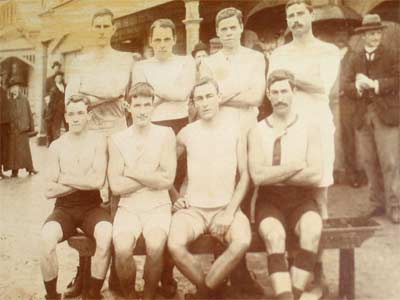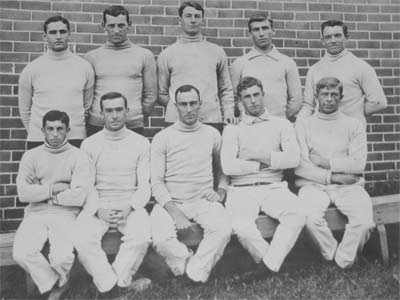History of Leichhardt Rowing Club
On these Bright Waters - A Centennial History of Leichhardt Rowing Club 1886-1986
Reproduced with permission of the author Merle Kavanagh
Table of Contents
Chapters
- The beginning
- Opening ceremony of club premises
- Early years
- 19th century social events
- Loss of the club's first shed
- Into the 20th century
- The social scene before the war
- The first world war
- Between the world wars
- The 2nd world war
- The winning years after WWII
- The struggles of the sixties and seventies
- The last decade
- Some rowing highlights
- Junior oarsmen
- Women
- Oarmanship
- Regattas and the fleet
- Some accidents and incidents
- Old boys/reunions
Appendices
- Some club personalities
- Honorary life members
- Trophies awarded
- Roll of office bearers
- Coaches and Coxswains
- Current Committee and members 1985-86
- Members of Leichhardt Old Oarsmen's Union
- NSWRA International representatives
- NSWRA Interstate representatives
- Successes in NSWRA Championships
- NSWRA Ladies Championships
- Boat race officials
- Members who served as NSWRA office bearers
6. Into the 20th Century
By the 1900s the club was back on its feet again. New lockers were installed in the shed, the boats, oars, sculls and lockers were insured for £300 in 1902 and notices appeared in the shed prohibiting dogs and stipulating that boats were not to be used for conveying members to the swimming baths. That same year it was decided to paint the riggers of the new eight red and blue, so it is assumed that by then the blue and buff colours had been changed.
The club negotiated with the trustees of Leichhardt Park for a twenty year lease of that portion of the park at that time (1902) occupied by the club. It was found that a new pontoon was needed and Mr Hawthorne M.L.A. was asked to help. The club shed needed painting and this was done for £11. The committee saw the need for a social committee to prepare a programme of social events for the first year 1902/3 and one was duly formed, but this was shortlived.

1903 NSW crew containing clubman R E Milsop in the three seat
But rowing was the club's main interest and this they proceeded to do style. Allan Ramsay was Hon. Coach and crews competed at most regattas. A racing fund had been formed for the purpose of providing trophies for club races and Mr. Connelly was appointed in August 1904 to supply the press with information.
By 1905 two club members, A.G. Partridge and Edward Kenny, had been selected among the first 22 to practise for interstate eight oar racing. Regattas were held regularly, with often both the "Bronzewing" and the "Lady Hopetoun" steamers being hired for spectators and official party.
In 1900, the Sydney Morning Herald and the Daily Telegraph were reporting "Leichhardt club provided an excellent crew and won the Maiden Fours Race in splendid style" OR "For a maiden crew, the form displayed by the winners (Leichhardt) was the best seen on the river for some time past." In 1906 the Petersham Standard was reporting "Mr. Ramsay, who coached the winning crew and the winners of the Maiden Fours, was heartily congratulated on their success. The Maiden Eight crew afterwards did a good row for the inter-state eight-oar crew selectors which was very favorably criticised, and Messrs. Baker, H. Hauenstein and Kolts have been asked if they could undertake the trip in May next to Western Australia, if selected."
By 1914 Leichhardt had won the coveted pennant, becoming the season's premiers. The Referee on 18th March 1914 said -
LEICHHARDT THE SEASON'S PREMIERS.
The open events at the St.Ignatius' regatta were the last of the 1913-14 season to carry points for premiership
honors, which go to the Leichhardt club. This is the first occasion on which the L.R.C. has won the
much-coveted pennant, their previous best performance being to win the Junior pennant, which they have
secured this season for the second time. The double win is deservedly popular with Sydney oarsmen,
for Leichhardt have been consistent performers at the various regattas, and their success in both Senior
and Junior divisions is the result of excellent organisation and the good coaching methods in vogue,
combined with enthusiasm among the members - always a big factor in club success.
In 1906 it was decided to procure new club singlets without sleeves and these were to have a red and blue shield on the front with the letters L.R.C. omitted. The Committee ordered 1 dozen 34", 4 dozen 36" and 1 dozen 38", altering the order from 2 dozen 38", adding this dozen onto the 36" size. The same year the pontoon was tarred and 60 yards of sheeting were purchased to cover the racing boats.
L.L. Ramsay was retained as architect for an extension to the club shed of 14 ft. to include new lockers. These were completed by early 1907, at a cost of £115.
Edwards and Son of Melbourne were asked by the Committee to supply a racing eight - "a boat to beat anything in Sydney Harbour, but not at the sacrifice of durability". This was supplied by early 1907 and the committee decreed that no person over 9 stone could sit in the stern of the boat except under exceptional circumstances. Coach Allan Ramsay almost resigned over this ruling until it was pointed out that he would be allowed to sit in the Cox seat as coach when he considered it absolutely necessary.
The lockers and their contents from time to time were a problem. Some members had their rowing clothes stolen from their lockers, despite threats of expulsion for anyone caught pilfering. Sometimes the state of the rowing clothes in the lockers were a source of contention. The windows of the dressing room were frosted in 1907, repairs made to the bathroom and water service and the gas line extended in 1910. A. B. Griffith was engaged that year to repair boats at 7/6d. per week, and a caretaker, W.J. Harriott, was also appointed.
The Sydney Harbour Trust wrote to the club in 1911 asking under what authority the club was in possession of the land below high water mark on which the shed stood. This resulted in negotiations with the Trust and the Council for a lease, which were completed the following year.
By 1913 there was talk of a new shed. The pontoon had been cleaned and retarred and the committee felt that a roof was needed over the balcony. Foundations and roofing were to be strengthened and extension of the clubhouse 15 ft. on the side of the Park wharf were mooted. Electric lighting for shed was discussed but this would not be done until 1926.
From 1907 the club had really made an effort. They had been represented in as many races as possible
and trained hard. The 1907/8 annual report
stated "Crew for champion eight coached under great disadvantages .. It was .. so dark when the crew
got afloat each evening that it was impossible for the coach to see how the men were rowing ... only beaten
by three quarters of a length in a three mile race after having led for 2 and 3/4 miles."
In that same year a presentation of a shaving set was made to Mr. Hauenstein, who was the club's first representative in a winning interstate crew (eight).

1908 NSW Crew in Melbourne with Harry Hauenstein in five seat
By the time they won both Junior and Senior Premierships in 1913/14, the club had been represented in every open oar event in the season.
